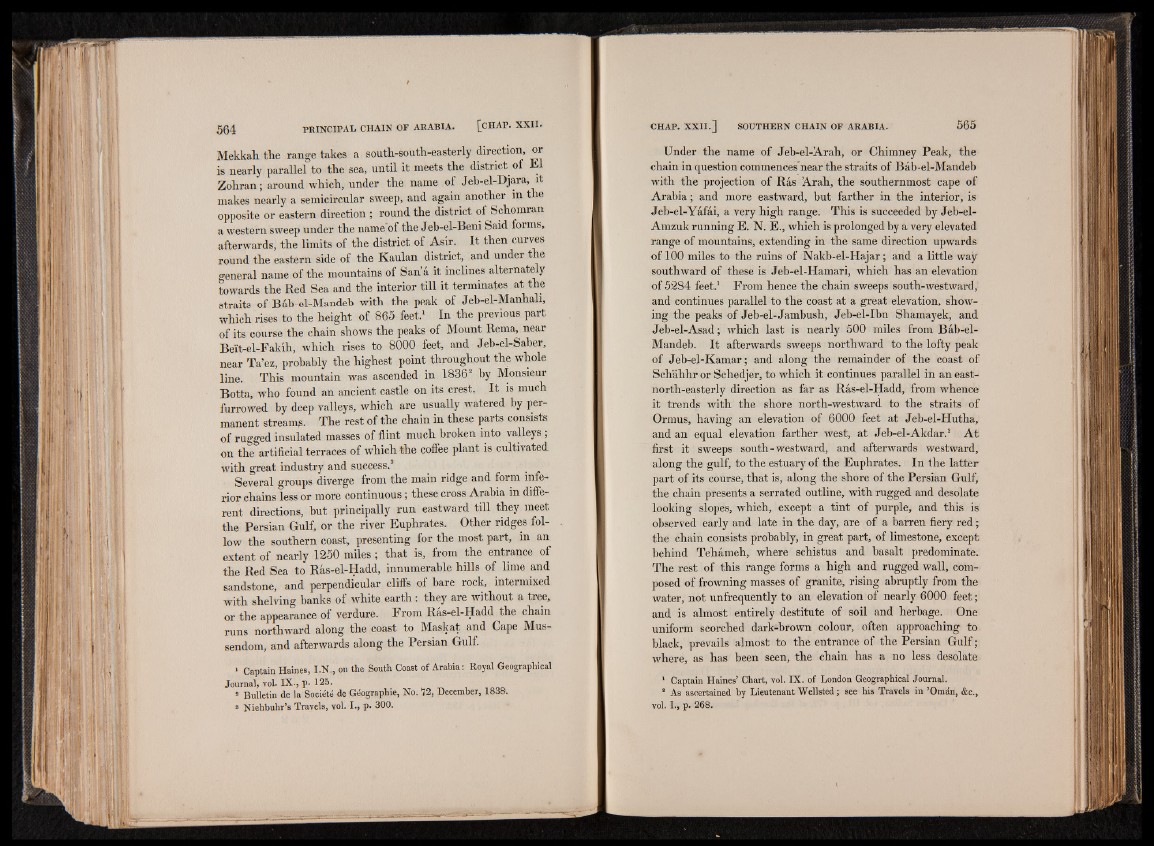
Mekkah the range takes a south-south-easterly direction, or
is nearly parallel to the sea, until it meets the district of
Zohran ; around which, under the name of Jeb-el-Djara, it
makes nearly a semicircular sweep, and again another in t e
opposite or eastern direction ; round the district of Schomran
a western sweep under the name of the Jeb-el-Beni Said forms,
afterwards, the limits of the district of Asir. It then curves
round the eastern side of the Kaulan district, and under t e
general name of the mountains of San a it inclines alternately
towards the Red Sea and the interior till it terminates at the
straits of Bab-el-Mandeb with the peak of Jeb-el-Manhali,
which rises to the height of 865 feet.1 In the previous part
of its course the chain shows the peaks of Mount Rema^ near
Be’it-el-Fakih, which rises to 8000 feet, and Jeb-el-Saber,
near Ta’ez, probably the highest point throughout the whole
line. This mountain was ascended in 18362 by Monsieur
Botta, who found an ancient castle on its crest, It is much
furrowed by deep valleys, which are usually watered by permanent
streamy. The rest of the chain in these parts consists
of rugged insulated masses of flint much broken into valleys ;
on the artificial terraces of which the coffee plant is cultivated
with great industry and success.®
Several groups diverge from the main ridge and form inferior
chains less or more continuous ; these cross Arabia in different
directions, but principally run eastward till they meet
the Persian Gulf, or the river Euphrates. Other ridges follow
the southern coast, presenting for the most part, in an
extent of nearly 1250 miles ; that is, from the entrance of
the Red Sea to Ras-el-Hadd, innumerable hills of lime and
sandstone, and perpendicular cliffs of bare rock, intermixed
with shelving banks of white earth : they are without a tree,
or the appearance of verdure. From Ras-el-Hadd the chain
runs northward along the coast to Maskat and Cape Mus-
sendom, and afterwards along the Persian Gulf.
1 Captain Haines, I.N., on the South Coast of Arabia: Royal Geographical
Journal, vol. IX., p. 125.
2 Bulletin de la Société de Géographie, No. 72, December, 1838.
8 Niehbuhr’s Travels, vol. I., p. 300.
Under the name of Jeb-el-Arah, or Chimney Peak, the
chain in question commences near the straits of Báb-el-Mandeb
with the projection of Rás Arah, the southernmost cape of
Arabia; and more eastward, but farther in the interior, is
Jeb-el-Yáfái, a very high range. This is succeeded by Jeb-el-
Amzuk running E. N. E., which is prolonged by a very elevated
range of mountains, extending in the same direction upwards
of 100 miles to the ruins of Nakb-el-Hajar; and a little way
southward of these is Jeb-el-Hamari, which has an elevation
of 5284 feet.1 From hence the chain sweeps south-westward,
and continues parallel to the coast at a great elevation, showing
tbe peaks of Jeb-el-Jambush, Jeb-el-Ibn Shamayek, and
Jeb-el-Asad; which last is nearly 500 miles from Báb-el-
Mandeb. It afterwards sweeps northward to the lofty peak
of Jeb-el-Kamar; and along the remainder of the coast of
Schahhr or Schedjer, to which it continues parallel in an east-
north-easterly direction as far as Rás-el-Hadd, from whence
it trends with the shore north-westward to the straits of
Ormus, having an elevation of 6000 feet at Jeb-el-Hutha,
and an equal elevation farther west, at Jeb-el-Akdar.2 At
first it sweeps south-westward, and afterwards westward,
along the gulf, to the estuary of the Euphrates. In the latter
part of its course, that is, along the shore of the Persian Gulf,
the chain presents a serrated outline, with rugged and desolate
looking slopes, which, except a tint of purple, and this is
observed early and late in the day, are of a barren fiery red;
the chain consists probably, in great part, of limestone, except
behind Tehámeh, where schistus and basalt predominate.
The rest of this range forms a high and rugged wall, composed
of frowning masses of granite, rising abruptly from the
water, not unfrequently to an elevation of nearly 6000 feet ;
and is almost entirely destitute of soil and herbage. One
uniform scorched dark-brown colour, often approaching to.
black, prevails almost to the entrance of the Persian Gulf;
where, as has been seen, the chain has a no less desolate
1 Captain Haines’ Chart, vol. IX. of London Geographical Journal.
8 As ascertained by Lieutenant Wellsted; see his Travels in ’Omán, &c.,
vol. I., p. 268.